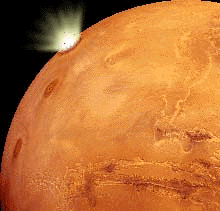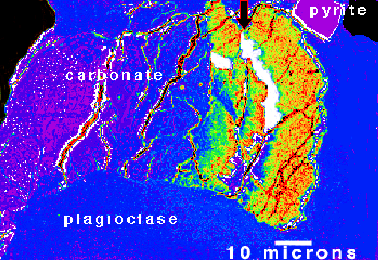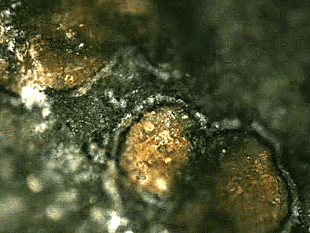|
|
|
|
|
|
|
Researchers at the Johnson Space Center and Stanford University have outlined four main lines of evidence that point to biological activity in Allan Hills (ALH) 84001 [Data link from Meteoritical Database] and, hence, that life once existed on Mars. They have carefully pointed out alternatives to each piece of the story, but they argue that taken as a whole, the best explanation for ALL the features associated with the orange carbonate globules in ALH 84001 is that tiny organisms lived on the surfaces of cracks.
Other scientists have devised even more alternatives than David McKay and his colleagues had considered, and a spirited debate is beginning. PSR Discoveries presents the evidence assembled by McKay and coworkers, along with the alternatives that have been discussed so far. Whatever the outcome of the debate, it seems certain that it will spark a great deal of research and we will end up knowing more about the geologic, and possibly biologic, history of Mars.
 |
Carbonate globules formed on Mars. |
 |
Carbonate globules formed from liquid water. |
 |
Polycyclic aromatic hydrocarbons. |
 |
Tiny grains of magnetite and iron sulfide. |
 |
Microfossils. |
|
|
[ About PSRD |
Archive |
Search |
Subscribe ] [ Glossary | General Resources | Comments | Top of page ] |
 by G. Jeffrey Taylor
by G. Jeffrey Taylor
| There is little doubt that a group of meteorites come from Mars. The evidence is described clearly in a report on the web site of the meteorite curators at the Johnson Space Center (see link on our title page). The ratios of the isotopes of oxygen indicate that ALH 84001 is also a member of that group, though it is much older than the others (over 4 billion years vs 1.3 billion years or less). The meteorite also contains trapped gases like those in the Martian atmosphere. It seems highly likely that ALH 84001 comes from Mars, and there is not much debate about this point. This is an artist's rendition of the impact that liberated ALH 84001 from the martian surface. (Graphic by Brooks Bays, PSR Discoveries graphic artist.) |  |
 |
There is also little dispute that the carbonate nodules formed before the meteorite arrived on Earth 13,000 years ago. As seen in this photograph, which has been colorize to highlight compositional distinctions, the prominent chemical zoning pattern is offset in some carbonate globules, undoubtedly because of an impact event that took place before arrival on Earth. An arrow points to the offset, shown prominently by the white bands. The formation age of the carbonates also indicates a pre-terrestrial origin for them. Although the age of the globules is highly uncertain, there is no question that they formed at least a billion years ago, long before the meteorite landed in Antarctica. (Image based on photograph by David Mittlefehldt.) |

by G. Jeffrey Taylor
 Survival of life like that on Earth requires hospitable conditions, most notably water. Data on the isotopic compositions of oxygen in the carbonate globules indicate that the carbonates formed between 0 and 80 degrees Celsius, appropriate for life to flourish. (NASA photo)
Survival of life like that on Earth requires hospitable conditions, most notably water. Data on the isotopic compositions of oxygen in the carbonate globules indicate that the carbonates formed between 0 and 80 degrees Celsius, appropriate for life to flourish. (NASA photo)
Alternative view of temperature.
|
|
[ About PSRD |
Archive |
Search |
Subscribe ] [ Glossary | General Resources | Comments | Top of page ] |